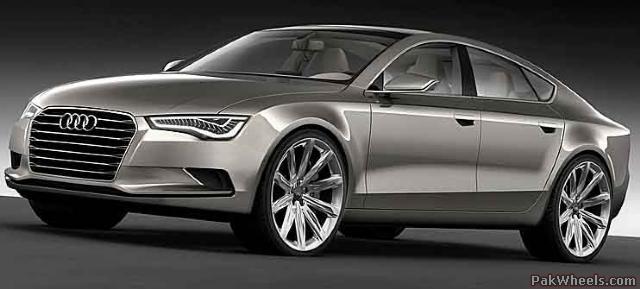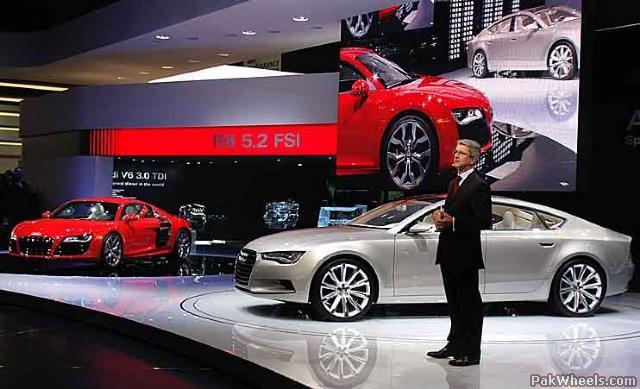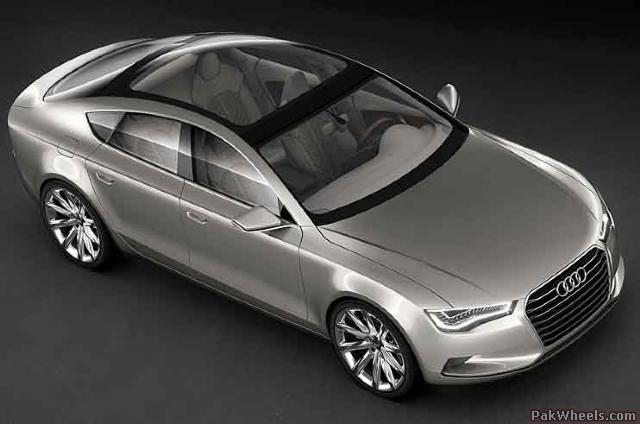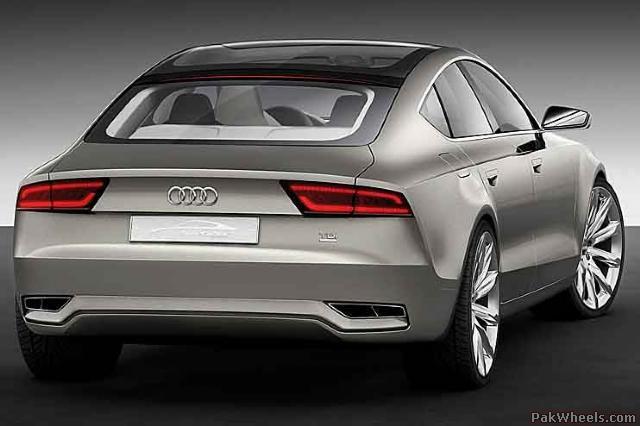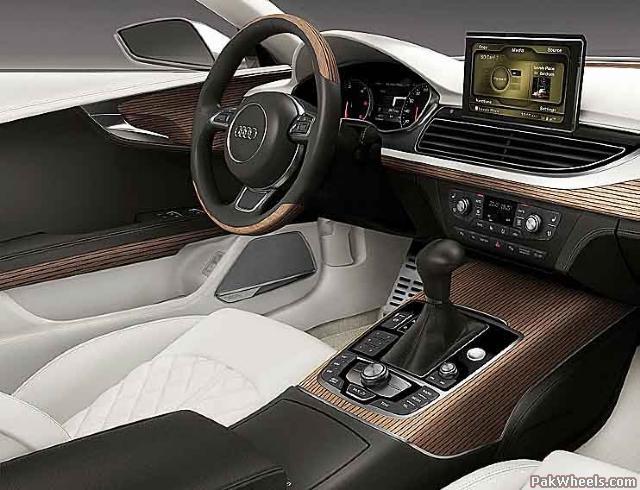AUDI SPORTBACK CONCEPT------------------------------------
Audi has unveiled its Sportback concept show car and a new R8 at the 2009 Detroit auto show.
With systematic refinements to the brand's characteristic design elements, the five-door model offers a glimpse at the Audi's future design vocabulary.
With its pronounced coupé-like silhouette and large rear hatch, the 4.95m long, 1.93m wide and only 1.40m high vehicle is boldly progressive for the luxury class.
The technology of the Audi Sportback concept is markedly futuristic. Power is provided by the world’s cleanest diesel technology: the three-litre V6 TDI clean diesel almost completely eliminates nitrogen oxidestechnology of the Audi Sportback concept is markedly futuristic.
This engine already meets the emissions limits of all 50 US states and the EU6 standard scheduled to take effect in 2014. The numerous measures to ensure top efficiency mean that the Audi Sportback concept is expected to achieve impressive fuel consumption figures of 5.9 litres of diesel per 100 kilometres.
The Audi Sportback concept show car is now progressing to the starting line with a dual mission: As suggested by the name, it symbolises the Sportback principle in its purest form combining elegance, sportiness and variability.
The show car also signals the company's determination not to limit Sportback versions to the compact segment. As previously indicated by the Audi A1 Sportback concept at the 2008 Paris auto show, Audi is going to dramatically expand the number of Sportback models on the marketSportback versions won't be limited to the compact segment.
The design of the Audi Sportback concept is characterised by an almost monolithic clarity and a vast reduction of the number of lines. The roof, shoulder and sill lines appear to have been drawn with a single stroke.
The window strip of the coupé, with its four frameless doors, was kept pronouncedly flat.
One feature, familiar from the two-door Audi A5 coupé, is even more boldly accentuated here: The markedly horizontal shoulder area emphasises the orientation of the vehicle body to the road. This effect is further reinforced at the front and rear by the broad, flat LED light units. The shape of the side mirrors is inspired by the upturned tips - the "winglets" - of modern jet wings.
The show car also offers a new interpretation of the single-frame grille. The decision not to use vertical struts and the low overall height emphasise the sporty basic proportions of the vehicle front. Also particularly striking is the modified outer contour of the single-frame grille also featured on the A1 Sportback show car.
The flattened top edges lower the visual centre of gravity and provide a striking look for the front end.
The interior design is tidy and downright purist yet elegant at the same time. The large glass roof underscores the width and feeling of spaciousness. In the driver-oriented cockpit, the air vents, instrument cluster and retracting MMI monitor are outlined by a filigree aluminium border.
As with the exterior, the interior is characterised by the emphasis on horizontal lines and large surfaces. Especially the wide centre console – stretching from the dashboard to the back – seems to be a pure expression of function. The flat display of the MMI system is installed as a retractable system in the show car. When the ignition is activated, it extends horizontally from a slot above the central air register before moving in an elegant arch into a vertical, easy-to-read position.
Four sporty seats await the driver and passengers. The diamond-shaped stitching of the leather surface is reminiscent of a classic GT tradition. Shoulder, head and leg room are reminiscent of a premium-class touring car. With a volume of 500 litres, the boot is generously sized and is also equipped with high-quality materials.
The developers at Audi chose the world's cleanest diesel technology as the unit best befitting the Audi Sportback concept show car. The six-cylinder 3.0 TDI clean diesel is equipped with a system for the effective reduction of nitrogen oxides. The diesel engine development engineers at Audi have combined an entire package of innovative measures for this latest TDI generation: The piezo common rail system with an injection pressure of 2,000 bars, highly efficient exhaust gas recirculation and optimised turbocharging result in significantly reduced raw engine emissions. One of the highlights is the combustion chamber sensors that enable even more precise regulation of the combustion processes in the engine - this is the first time that such sensors have been installed on any engine in the world, marking yet another Audi innovation.
The V6 produces 165 kW and 550 Nm of torque in the Audi Sportback concept. Power is transferred to the wheels via Audi’s most modern transmission: the new 7-speed S tronic. The quattro permanent all-wheel-drive system ensures that the torque generated by the powerful TDI is also converted effectively into propulsion and dynamism under any conditions.
Weighing just 1800kg and with a drag coefficient of 0.30, the coupe will accelerate to 100km/h in less than seven seconds and reach a top speed of 245km/h. The Audi Sportback concept’s average fuel economy according to the European ECE standard is only 5.9 litres of diesel per 100km and its CO2 emissions no more than 156 g/km. These low figures for a large model have been achieved by extensive efficiency-optimising measures.
For example, this model's electromechanical power steering only consumes energy when the steering is turned, not when driving in a straight line.
The TDI engine features an innovative temperature management system. When the engine is warming up, part of the coolant flow is diverted – another way to improve efficiency, since it helps the engine to warm up quicker.
This means significant practical savings, because many journeys are fairly short. The fuel pump also runs only when there is a demand for fuel, and therefore uses less energy.
The seven-speed S tronic transmission is a very efficient unit with a wide spread of gear ratios. For the first time, it has been equipped with transmission oil heating, so that it reaches its intended operating temperature much earlier and therefore has a lower level of internal friction.
When coasting, the Audi Sportback concept – like the Audi A4 and Audi Q5 production models – recovers energy. This boosts the output of the alternator and is used to charge the battery. This energy, which in effect costs nothing to recover, is fed back into the vehicle’s electrical system when needed. An automatic start-stop system shuts the TDI engine down to save energy, for instance when waiting at a traffic signal. And when it is on the move, tyres optimised for low rolling resistance cut fuel consumption significantly without incurring any disadvantages in the performance area.
The Audi Sportback concept show car took the basic architecture and many components of its suspension from the brand’s latest and most successful model family: the very dynamic A4/A5 model series. The dynamic suspension sets standards here, as well, combining precision and dynamism with high stability and superior poise. The suspension mountings, steering, wheels and brakes have been developed for top performance and numerous aluminium components are used to keep unsprung masses to a minimum.
The show car marks the first time that Audi has used electromechanical steering in a car with a longitudinal engine. Its primary advantage is that, unlike conventional power steering systems, it only consumes energy when actually steering. On average, this means a fuel saving of 0.2 litres/100km, depending on driving conditions.
The Audi Sportback concept is equipped with ceramic brakes on all four wheels for effective deceleration even under the most demanding conditions. Compared with conventional steel discs, ceramic brakes not only last for as much as 300 000km but also offers high resistance to fading. The significant reduction in weight also leads to advantages in terms of comfort and handling, thanks to reduced unsprung masses.
On the front axle, 380mm ceramic discs are fitted in combination with 21-inch wheels. The rear discs have a diameter of 356mm. The elaborate cooling-duct geometry of the ventilated brake disks ensures optimal cooling of the brake discs. Firm grip on the brake disc is guaranteed at the front by six-piston aluminium brake callipers, and at the rear by floating-callipers.
